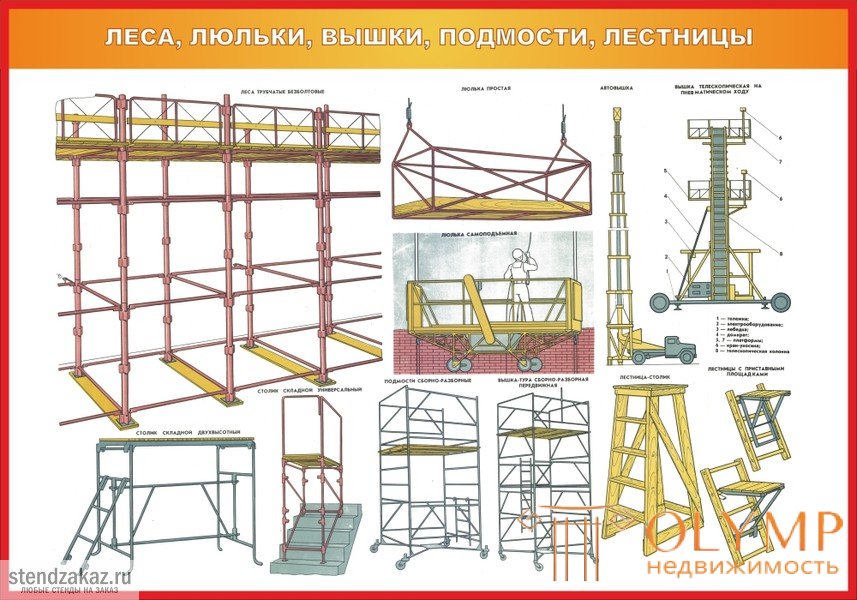
When finishing a building or structure, it is necessary to perform work at a height, while for the placement of materials and workers, ancillary devices are made - scaffolding, scaffolding, cradles. Scaffolding is usually arranged indoors, forests - outside. For the decoration of high premises also arrange forests. When finishing work used inventory collapsible scaffolding and scaffolding that meet the requirements of industrial construction.
Scaffolding and scaffolding installed on a strong and dense planned base. If the forests are supposed to be used for a long time, ditches are made on the site for draining rainwater so that the soil is not washed out from under the stands of the forests.
The width of the flooring on scaffolding and scaffolding should be not less than 1.5 m, the height between the floorings in the light - not less than 1.8 m. The flooring should have a flat surface. Between boards or shields a gap of not more than 10 mm is permissible. If the flooring is solid, then it is allowed to dock the boards with an overlap along their length, after having previously mowed the ends of the boards. Have the ends on the support (run) so that each of them overlaps the support (run) not less than 20 cm in both directions.
When plastering facades, the distance from the flooring to the wall should not exceed 150 mm, while plastering the internal surfaces - 100 mm. These gaps are covered with removable boards.
Scaffold decks located above 1.1 m from the ground level must have fences with a height of at least 1 m. All loads on the scaffolding and scaffolding must not exceed the norms established by calculation.
For communication between the forest tiers, stairs are installed (with a slope of no more than 60 °), the upper ends of which are fastened. It is forbidden to carry heavy loads on ladders and stack them on the landing.
In order to avoid electric shock, workers should not touch the scaffolding. Suspended electrical wires are fixed on insulators. Scaffolding must be grounded. After scaffolding and scaffolding up to 4 m high, they are accepted by the construction company, and above 4 m the commission; The acceptance certificate is approved by the chief engineer of the building organization.
In places where materials are stored, posters are displayed indicating the load that forests sustain and the location of materials.
Scaffolding and scaffolding are assembled and disassembled by instructed workers.
It is forbidden to work on forests with thunderstorms and winds of 6 points or more.
Ladders, step-ladders, platforms and transitions should be kept clean by removing debris, mortar and residues from them. In winter, they should be systematically cleaned of snow, frost and, moreover, sprinkled with sand.
Working on scaffolding at a height of over 6 m is permitted if at least two floorings are arranged: working (top) and protective. When it is necessary to perform work simultaneously from two floorings located on different tiers, then there should be a third flooring under them. Work in several tiers in a single vertical without intermediate flooring between them is prohibited.
When constructing a solid flooring of tables or carts put together, tables and carts are fastened together.
Transportation of materials in wheelbarrows through forests and scaffolding is permitted only on condition that the rolling steps are arranged.
The load supplied to the scaffolding and scaffolding should be lowered smoothly, without impacts. Lifting mechanisms should not transfer additional loads on the scaffolding, if it is not provided for by their design.
In order to prevent the spontaneous expansion of the ladders, restrictive chains or hooks are attached to their string.

Что бы оставить комментарий войдите
Комментарии (0)